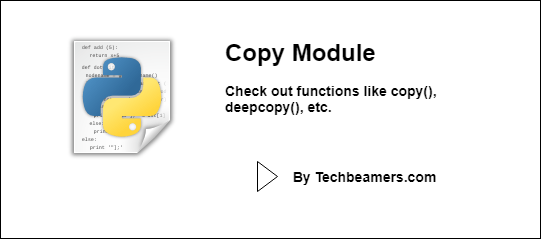Welcome to an exciting tutorial where you’ll delve into the fascinating world of the Python Copy module! Prepare yourself for a thrilling learning experience that will have you mastering this module in no time.
When it comes to picking up new concepts, the Python Copy module is a breeze. With its user-friendly approach, it offers a shorter learning curve compared to other modules. If you’re already well-versed in other Python topics, you’ll find yourself comfortably sailing through this tutorial.
But wait, there’s more! We understand that everyone has their own preferences, so don’t worry if you’re not using Python 3. You have the freedom to adapt the examples and syntax in this tutorial to suit your preferred Python version. We’re all about flexibility here!
So, get ready to embark on a thrilling journey as we uncover the wonders of the Python Copy module. Brace yourself for a captivating learning experience that will leave you empowered and eager to explore the endless possibilities it offers. Let’s dive in!
Let’s unleash the Power of the Copy Module!
What is Copy Module?
Copy Module is a set of functions that are related to copying different elements of a list, objects, arrays, etc. It can be used to create shallow copies as well as deep copies.
The difference between shallow and deep copy operations got explained in a tutorial on Deep Copy vs. Shallow Copy in Python.
How does the Copy module work?
The syntax to use the Copy Module is shown below:
import copy copy.submodule_name(arguments)
To perform the shallow copy, you can use the following code:
import copy copy.copy(object_name)
If you want to create a deep copy, follow the below approach:
import copy copy.deepcopy(object_name)
In the next section, a few programs are implemented to demonstrate the Copy Module in Python 3.
Program Examples
Create the shallow copy of a list:
Here is a simple Python script to demonstrate the Shallow Copy.
import copy a = [ [1, 2, 3], [4, 5, 6] ] b = copy.copy(a) print(a) print(b) a[1][2] = 23 b[0][0] = 98 print(a) print(b)
The output will come as:

Create a deep copy of a list:
Check for another Python code example demonstrating the deep copy operation.
import copy a = [ [1, 2, 3], [4, 5, 6] ] b = copy.deepcopy(a) print(a) print(b) a[1][2] = 23 b[0][0] = 98 print(a) print(b)
The output will come as:

Wrapping up: Python Copy Module
Congratulations! You have completed the Python Copy module tutorial and have gained valuable knowledge on how to copy and deep copy objects in Python. You can now confidently use the copy module to manipulate data structures and objects with ease.
As you continue on your Python journey, remember to explore and experiment with the various modules and packages available. The Copy module is just one of many that can simplify your coding and help you achieve your goals more efficiently.
Follow some more related tutorials below.
We hope that you enjoyed this tutorial and found it useful. Keep learning and pushing your boundaries to become a Python expert. Thank you for choosing to learn with us!









